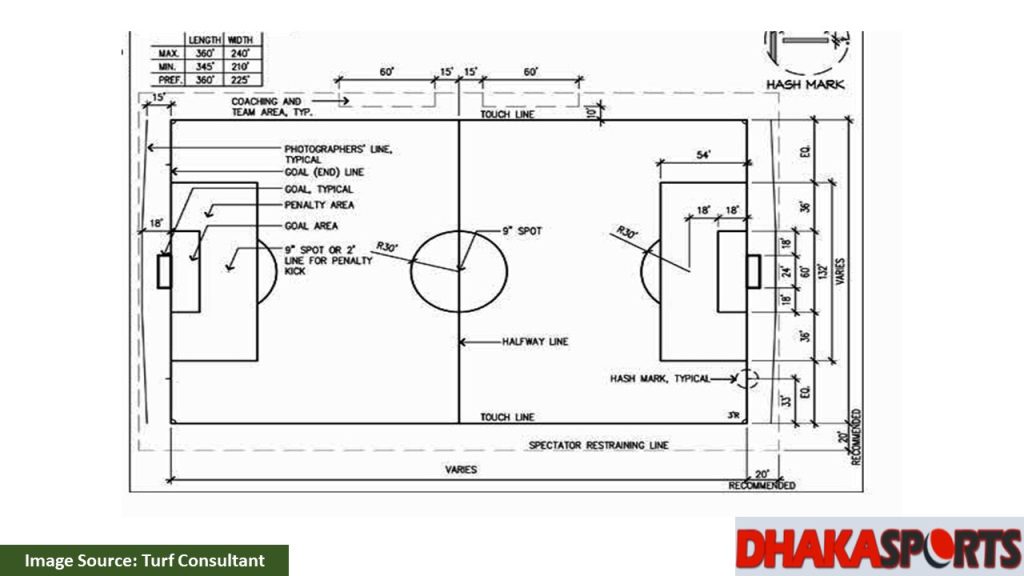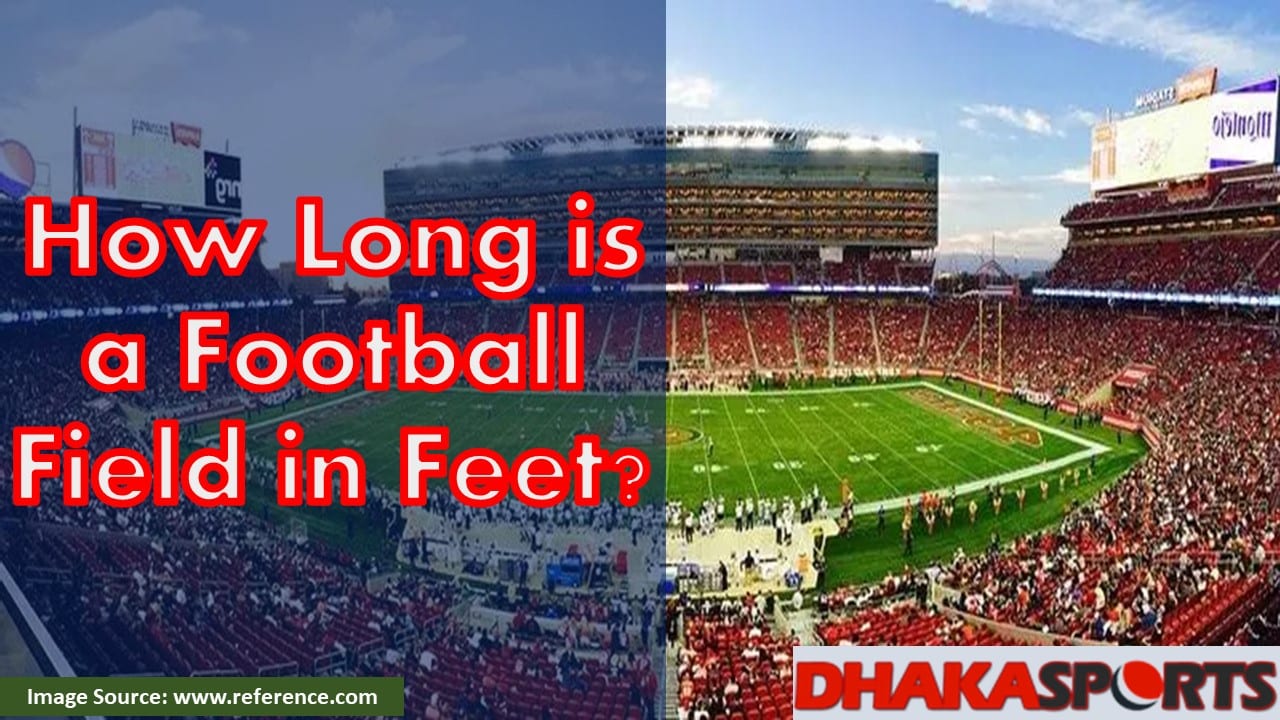Because the football field is so enormous, its size will have an impact not just on the game as a whole but also on the strategies used by the players.
Having said that, are you familiar with the American football field measurements in their entirety? Also, how many yards is a football field, including the end zone, when measured from end to end? If you have any questions regarding the response, let’s find out what Dhaka Sports has to say about it!
How Long Is a Football Field in Feet?
The combat will take place on a field that is rectangular in shape and has two indicators: the length of the field is 360 feet, and the width is 160 feet.
The length of the playing field is 100 meters, and the end areas are each 10 meters deep. If you include the end zones, a football field has a total area of 57,600 square feet (1.32 acres), making it the largest athletic playing surface in the world. Each hash mark on the field is measured to be 100 yards, and there are markings every five yards and every 10 yards on both sides. In addition, there are markers for every number of fields.
The Actual Dimensions of NFL Football Field
As a consequence of the initial rule modifications in 1933, which represented one of the first significant departures from schools, those two sets of hash markings and numbers were first visible on professional football fields for the first time. This was one of the first big deviations from college football.
Each play begins from the most recent pound sign to the conclusion of the preceding play, unless that play ended outside of a pound sign, including on the margin. In that case, the next play will begin from the beginning of the previous play.
Therefore, since there is more space between the sharp sets and the touchline, there is more room for the ball carrier to spin and maneuver past the defenders. This is because there is less space between the sharp sets.
In the same vein, the width of the field is standard throughout all levels of competition, from high schools to colleges to the NFL. The only factor that changes from level to level is the yardage gap that exists between each pair of yard lines.
The sharps in American high school football are set at a distance of 53 feet and 4 inches apart. In college, the distance is shortened to 40 feet, and in the NFL, it is shortened to 18 feet and 6 inches.
Differences Between College, Pro, And High School Football Field Dimensions
The score column is the primary feature that differentiates football fields used at high schools, colleges, and professional levels. High school football rankings use target posts with a width of 23 feet, 4 inches.
On the other hand, college football ranks and professional football ranks use target posts with a width of 18 feet and 6 inches. Every one of the target poles is elevated by ten feet above the ground. It is recommended that the goal lines be padded up to a height of six feet above the ground.
In addition, the letter “G” will be written on the high schools that are situated on the target line. It is also important to note that on high school fields, little signs are often positioned at the 10th, 20th, 30th, 40th, and 50th lines just outside the field to offer players visual help.
On American football fields used on the professional level, the coach and team boxes may have slightly different dimensions from those used in college or high school football.

Why Are a Football Field 100 Yards?
In 1912, the end zone was added to American football fields, shortening their useful life. As a result, many fields couldn’t be used if they were renovated to accommodate a 110-yard field. Therefore the length of a football pitch was shortened to 100 yards.
Canadian Football Field Dimensions
Canadian football uses a rectangular field 110 yards in length from line to line, with an extra 20 yards added to either end. Target poles are situated beyond the line of aim. Binoculars are a great tool for any game, so don’t leave home without them.
What Is the Average Length of An NFL Stadium in the USA?
You probably already know that a stadium includes the fields, stands, and other components necessary to host a football game or other sporting event. There is a wide range in the size of stadiums. It’s crucial that they clear enough space for a football field with a 100-foot width.
Dome stadiums and outdoor stadiums are the two primary types of venues used for professional and collegiate football, respectively. Players and spectators in covered stadiums are protected from the elements.
There is always a roof above the field, and the teams always play on artificial grass. When it comes to the size of the crowd, both sorts of stadiums can house anywhere from 50,000 to 107,000 yelling football fans.
The Field Marks
Many white lines may be seen in the diagram depicting the size of an American football field. To guarantee that the game is played according to the rules and to aid in navigation, each line is assigned a specific meaning:
- End Lines: Both ends of the field have lines drawn on them.
- Horizontal Lines: The field is bordered by lines on both sides.
- Target Lines: Each ending line is 10 yards in, and the lines of fire are parallel to them.
- The Playing Field: The space enclosed by the sidelines and the goal line is this size.
- 50-Yard Line: The field’s center 50-yard line serves as a dividing line for both halves.
- End Zone: Those are two distinct areas separated by terminal and goal lines.
- Lines: Elements of the dimensions, these go from line to line across the field for a total of 5 yards in a parallel direction to the goal line. In the NFL, these lines are not drawn any higher than 8 inches over the solid 6-foot line.
- Hash Marks: Each NFL line is 70 yards and 9 inches long, and the hash indicates that distance. Football fields used at the collegiate and high school levels include distinct hash markings placed 60 yards from each sideline. Both sets of sharps are roughly 18 1/2 feet apart and run the length of the field in a parallel fashion.
- Players Bench: The white line 6 feet beyond the court line is an extra part of the court size. The locations where coaches and substitutes are allowed to stand are denoted by a separate dashed white line.
Just as in basketball, the squad gathers on the bench area to cheer on their fellow players and to relax while others get some rest. Injured athletes are evaluated by medical staff and coaches in this area as well. It’s everything happening outside the primary dimensions of the field.
The Football Field Surface
The sport of football may be played on a variety of surfaces, including natural grass and artificial turf. Each one has a unique set of benefits and drawbacks:
- Natural Grass: Natural grass is like your backyard or a baseball field: beautiful, green grass has to be mowed, watered, and regenerated.
- Artificial Grass: Some artificial surfaces are comprised of short nylon grass blades. Other man-made surfaces feature cushioned weaves. Artificial turf requires less maintenance than real grass.
The Goal Post
At collegiate and professional competitions, the standers are 20 feet tall and are mounted on goalposts that are 18 feet 6 inches wide. The goalposts at the high school level are substantially wider, measuring 23 feet 4 inches.
The entire height of the score column is altered to reflect the difficulty of the game being played. The goalposts used in the National Football League are at least 35 feet high, while those used in college and high school games are also at least 10 meters high.
The Football Size
Depending on the player’s age, they utilize a football of different sizes while playing American football. Younger athletes often play with a ball that is scaled down to fit their smaller hands. Full-size footballs are utilized in high school and college games, as well as in the NFL. A complete list of the American football measurements that are required at all playing levels can be found below.
- Junior Leagues (Usually for Ages 9-12): 6 inches wide, 10.5 inches long, 18.5 inches in diameter.
- Youth Tournaments (Usually for Ages 12-14): 11 inches long, 6.5 inches wide, 19.5 inches in diameter.
- High School: The standard size of a high school student football ball is 11 inches long, 7 inches wide, and 21 inches in diameter.
- University: 11 inches long, 7 inches wide, 21 inches in diameter.
- NFL: 11 inches long, 7 inches wide, 21 inches in diameter.
Final Thoughts
As a result of reading this article, we now know the appropriate response to the question “how long are football fields in feet?” along with the value of its hash marks. A single-field football would measure exactly 120 yards long (or 360 feet long) and 53 and a half yards broad (or 160 feet wide).
You may also get further knowledge on the many components of a football field and the sizes of those components. Not only does the size of the whole playing field have to adhere to certain requirements, but so must the size of each individual portion on the field!
